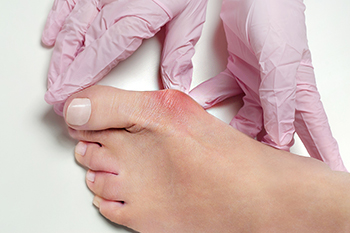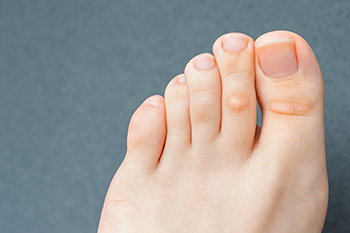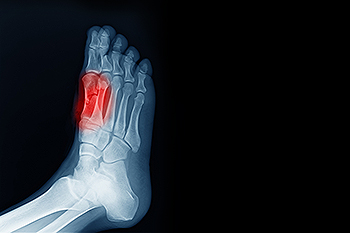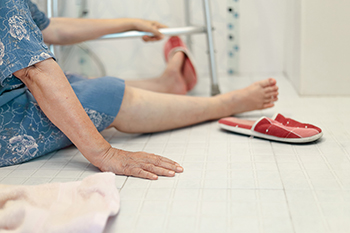Items filtered by date: April 2023
Why Live with Pain and Numbness in Your Feet?
Relief Options for Bunions

A small hardened lump on the outside of the big toe may indicate a bunion has formed. It can grow in size if treatment is not sought, and can cause the other toes to shift toward each other. Bunions form as a result of genetic factors, or they may happen from wearing shoes that do not have adequate room for the toes to move in freely. It is considered to be a deformity and may be painful, often causing difficulty in walking. Some patients notice there is redness and swelling surrounding the bunion, and it may reduce range of motion in the big toe. Relief may be found when the correct size shoes are worn, with enough room for the toes to move in. Additionally, orthotics may be worn which may improve comfort and foot alignment. Corns may form on top of the bunion, where it rubs against the shoe, and wearing a protective pad over the bunion may temporarily provide relief. If you have a bunion, it is suggested that you consult with a podiatrist who can offer you treatment solutions, which may include minor surgery for permanent removal.
If you are suffering from bunion pain, contact Anas Khoury, DPM of North Eastern Foot & Ankle Specialists. Our doctor can provide the care you need to keep you pain-free and on your feet.
What Is a Bunion?
Bunions are painful bony bumps that usually develop on the inside of the foot at the joint of the big toe. As the deformity increases over time, it may become painful to walk and wear shoes. Women are more likely to exacerbate existing bunions since they often wear tight, narrow shoes that shift their toes together. Bunion pain can be relieved by wearing wider shoes with enough room for the toes.
Causes
- Genetics – some people inherit feet that are more prone to bunion development
- Inflammatory Conditions - rheumatoid arthritis and polio may cause bunion development
Symptoms
- Redness and inflammation
- Pain and tenderness
- Callus or corns on the bump
- Restricted motion in the big toe
In order to diagnose your bunion, your podiatrist may ask about your medical history, symptoms, and general health. Your doctor might also order an x-ray to take a closer look at your feet. Nonsurgical treatment options include orthotics, padding, icing, changes in footwear, and medication. If nonsurgical treatments don’t alleviate your bunion pain, surgery may be necessary.
If you have any questions, please feel free to contact our office located in Passaic, NJ . We offer the newest diagnostic and treatment technologies for all your foot care needs.
Corns Can Be Surprisingly Painful

A corn can be painful, despite its small size. They generally develop as a result of excess friction caused by the shoes worn, and the pain can alter the gait, or walking style. Common places for corns to develop can be the side of the pinky toe or on top of the toes. Prevention methods can include wearing shoes and socks that fit correctly, and it may help to moisturize the feet frequently. Many people find comfort in wearing insoles or heel pads in their shoes and soaking the corn in warm water at the end of the day. This may help to soften it and can make it easier to use a pumice stone that can file down small corns. If the corns are recurring, it is suggested that you consult with a podiatrist who can guide you toward additional prevention methods.
If you have any concerns regarding your feet and ankles, contact Anas Khoury, DPM of North Eastern Foot & Ankle Specialists. Our doctor will treat your foot and ankle needs.
Corns: What Are They? and How Do You Get Rid of Them?
Corns can be described as areas of the skin that have thickened to the point of becoming painful or irritating. They are often layers and layers of the skin that have become dry and rough, and are normally smaller than calluses.
Ways to Prevent Corns
There are many ways to get rid of painful corns such as wearing:
- Well-fitting socks
- Comfortable shoes that are not tight around your foot
- Shoes that offer support
Treating Corns
Treatment of corns involves removing the dead skin that has built up in the specific area of the foot. Consult with Our doctor to determine the best treatment option for your case of corns.
If you have any questions please feel free to contact our office located in Passaic, NJ . We offer the newest diagnostic and treatment technologies for all your foot and ankle needs.
Forefoot Pain

The forefoot is the front part of the foot that contains ligaments, tendons, muscles, nerves, blood vessels, metatarsal bones, and phalanges. The metatarsal bones are the five long bones between the toe bones, the hindfoot, and the midfoot. There are a variety of conditions that can lead to forefoot pain, including Morton’s neuroma, toe pain, and sesamoiditis. The focus here is on sesamoiditis. Most bones are connected to other bones at joints. Sesamoids are bones embedded in muscle and only connected to tendons. On the bottom of the foot, near the big toe, two small sesamoids help with weight bearing and raising the bones of the big toe. Sesamoiditis happens when these tendons become irritated and inflamed. This is common among runners and dancers. If you suffer from pain in your forefoot, it is suggested that you visit a podiatrist to determine the cause of the pain, whether it’s sesamoiditis, and how to treat it best.
Sesamoiditis is an unpleasant foot condition characterized by pain in the balls of the feet. If you think you’re struggling with sesamoiditis, contact Anas Khoury, DPM of North Eastern Foot & Ankle Specialists. Our doctor will treat your condition thoroughly and effectively.
Sesamoiditis
Sesamoiditis is a condition of the foot that affects the ball of the foot. It is more common in younger people than it is in older people. It can also occur with people who have begun a new exercise program, since their bodies are adjusting to the new physical regimen. Pain may also be caused by the inflammation of tendons surrounding the bones. It is important to seek treatment in its early stages because if you ignore the pain, this condition can lead to more serious problems such as severe irritation and bone fractures.
Causes of Sesamoiditis
- Sudden increase in activity
- Increase in physically strenuous movement without a proper warm up or build up
- Foot structure: those who have smaller, bonier feet or those with a high arch may be more susceptible
Treatment for sesamoiditis is non-invasive and simple. Doctors may recommend a strict rest period where the patient forgoes most physical activity. This will help give the patient time to heal their feet through limited activity. For serious cases, it is best to speak with your doctor to determine a treatment option that will help your specific needs.
If you have any questions please feel free to contact our office located in Passaic, NJ . We offer the newest diagnostic and treatment technologies for all your foot and ankle needs.
Falls and Fractures in Seniors

Thousands of seniors fall and break bones yearly. A broken bone in people in this age group can seriously interfere with mobility and lead to more serious health problems. Falls can be prevented by exercising to maintain strength and flexibility, having medications, vision, and health checked regularly, and employing home safety measures. Staying physically active is essential in keeping one’s body healthy throughout life. Poor eyesight and slower reflexes can contribute to falls. Taking medications with side effects that cause dizziness or confusion or having a health condition, such as diabetes or heart disease, can affect balance and cause falls. Hazards such as wet floors, poor lighting, or rugs not securely fastened to the floor can all contribute to falls in the home. If you are an older adult, it is suggested that you visit a podiatrist who can provide additional tips to help you prevent falls and fractures.
Preventing falls among the elderly is very important. If you are older and have fallen or fear that you are prone to falling, consult with Anas Khoury, DPM from North Eastern Foot & Ankle Specialists. Our doctor will assess your condition and provide you with quality advice and care.
Every 11 seconds, an elderly American is being treated in an emergency room for a fall related injury. Falls are the leading cause of head and hip injuries for those 65 and older. Due to decreases in strength, balance, senses, and lack of awareness, elderly persons are very susceptible to falling. Thankfully, there are a number of things older persons can do to prevent falls.
How to Prevent Falls
Some effective methods that older persons can do to prevent falls include:
- Enrolling in strength and balance exercise program to increase balance and strength
- Periodically having your sight and hearing checked
- Discuss any medications you have with a doctor to see if it increases the risk of falling
- Clearing the house of falling hazards and installing devices like grab bars and railings
- Utilizing a walker or cane
- Wearing shoes that provide good support and cushioning
- Talking to family members about falling and increasing awareness
Falling can be a traumatic and embarrassing experience for elderly persons; this can make them less willing to leave the house, and less willing to talk to someone about their fears of falling. Doing such things, however, will increase the likelihood of tripping or losing one’s balance. Knowing the causes of falling and how to prevent them is the best way to mitigate the risk of serious injury.
If you have any questions, please feel free to contact our office located in Passaic, NJ . We offer the newest diagnostic and treatment technologies for all your foot care needs.

